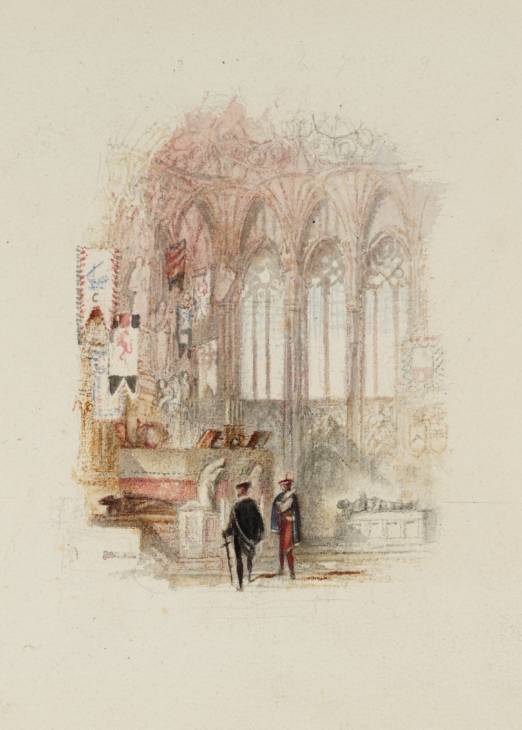Joseph Mallord William Turner Cortes and Pizarro, for Rogers's 'Poems' c.1830-2
Joseph Mallord William Turner,
Cortes and Pizarro, for Rogers's 'Poems'
c.1830-2
Joseph Mallord William Turner 1775–1851
Cortes and Pizarro, for Rogers’s ‘Poems’ circa 1830–2
D27709
Turner Bequest CCLXXX 192
Turner Bequest CCLXXX 192
Gouache, pencil and watercolour, approximately 130 x 100 mm on white wove paper, 243 x 288 mm
Stamped in black ‘CCLXXX 192’ bottom right
Stamped in black ‘CCLXXX 192’ bottom right
Accepted by the nation as part of the Turner Bequest 1856
Exhibition history
1904
National Gallery, London, various dates to at least 1904 (250).
1936
Four Screens, British Museum, London, July 1936–February 1937 (no catalogue but numbered 11).
1975
Turner and the Poets: Engravings and Watercolours from his Later Period, Marble Hill House, Twickenham, April–June 1975, University of East Anglia, Norwich, June–July 1975, Central Art Gallery, Wolverhampton, July–August 1975 (XI).
1993
J.M.W. Turner 1775–1851: Impressions de Gran Bretanya i el Continent Europeu / Impresiones de Gran Bretaña y el Continente Europeo, Centre Cultural de la Fundació ”la Caixa”, Barcelona, September–November 1993, Sala de Exposiciones de la Fundación ”la Caixa”, Madrid, November 1993–January 1994 (53, reproduced in colour).
1994
J.M.W. Turner 1775–1851: Aquarelles et Dessins du Legs Turner: Collection de la Tate Gallery, Londres / Watercolours and Drawings from the Turner Bequest: Collection from the Tate Gallery, London, Palais des Beaux-Arts de Charleroi, September–December 1994 (53, reproduced in colour).
References
1903
E.T. Cook and Alexander Wedderburn (eds.), Library Edition: The Works of John Ruskin: Volume I: Early Prose Writings 1834–1843, London 1903, pp.233, 244.
1904
E.T. Cook and Alexander Wedderburn (eds.), Library Edition: The Works of John Ruskin: Volume XIII: Turner: The Harbours of England; Catalogues and Notes, London 1904, pp.380–1.
1906
E.T. Cook and Alexander Wedderburn (eds.), Library Edition: The Works of John Ruskin: Volume XXI: The Ruskin Art Collection at Oxford, London 1906, p.214.
1909
A.J. Finberg, A Complete Inventory of the Drawings in the Turner Bequest, London 1909, vol.II, p.903, as ‘Cortez and Pizarro’.
1966
Adele Holcomb, ‘J.M.W. Turner’s Illustrations to the Poets’, unpublished Ph.D thesis, University of California, Los Angeles 1966, pp.96–7.
1975
Mordechai Omer, Turner and the Poets: Engravings and Watercolours from his Later Period, exhibition catalogue, Marble Hill House, Twickenham 1975, [pp.23–24].
1979
Andrew Wilton, The Life and Work of J.M.W. Turner, Fribourg 1979, p.444 no.1208.
1993
Ian Warrell, J.M.W. Turner 1775–1851: Impressions de Gran Bretanya i el Continent Europeu / Impresiones de Gran Bretaña y el Continente Europeo, exhibition catalogue, Centre Cultural de la Fundació ”la Caixa”, Barcelona 1993, pp.168–9 no.53, reproduced colour, 279.
1994
Ian Warrell, J.M.W. Turner 1775–1851: Aquarelles et Dessins du Legs Turner: Collection de la Tate Gallery, Londres / Watercolours and Drawings from the Turner Bequest: Collection from the Tate Gallery, London, exhibition catalogue, Palais des Beaux-Arts de Charleroi 1994, pp.31, 170–1 no.53, reproduced (colour).
1992
Jan Piggott, ‘Turner’s “Columbus” Vignettes’, Turner Society News, no.61, August 1992, pp.11, 12.
1993
Jan Piggott, Turner’s Vignettes, exhibition catalogue, Tate Gallery, London 1993, p.97.
This vignette, Cortes and Pizarro is the last of seven illustrations that Turner produced for ‘The Voyage of Columbus’, the last work in Rogers’s Poems (for a brief description see Tate D27705; Turner Bequest CCLXXX 188). The seven vignettes in order of their appearance in Rogers’s text are: Tate D27705, D27706, D27714, D27707, D27708, D27719, D27709; Turner Bequest CCLXXX 188, 189, 197, 190, 191, 202, 192.
Like the rest of the ‘Columbus’ series, Cortes and Pizarro was engraved by Edward Goodall.1 The design appears as the head-piece to the epilogue of the poem,2 in which Rogers recounts the fabled visit of the Spanish conquistadors, Hernán Cortés (1485–1547) and Francisco Pizarro ( circa 1471 or 1476–1841) to the Convent of La Rabida, where they pay homage to Columbus:
They entered, and from aisle to aisle
Wandered with folded arms awhile,
Where on his altar-tomb reclined
The crosiered Abbot; and the Knight
In harness for the Christian’s fight,
His hands in supplication joined;–
Then said as in a solemn mood,
“Now stand we where COLUMBUS stood!”
(Poems, p.268)
Wandered with folded arms awhile,
Where on his altar-tomb reclined
The crosiered Abbot; and the Knight
In harness for the Christian’s fight,
His hands in supplication joined;–
Then said as in a solemn mood,
“Now stand we where COLUMBUS stood!”
(Poems, p.268)
The ‘Columbus’ series therefore ends as it began, at the Convent of La Rabida (see Tate D27705; Turner Bequest CCLXXX 188). Turner shows the two men standing in the beautiful convent church gazing upon the standard of Columbus which can be seen at the far left of the composition, bearing the letter ‘C’ and the emblem of a ship. Light is streaming in through the windows, although this is more prominent in the engraved version than in the watercolour. Both of the Spaniards are richly dressed and appear as Rogers describes them in his text; Cortes wears a velvet cap and an ermine-fringed vest, while the figure with the long black cape, resting his hand on the hilt of his sword is Pizarro.3 The cross formed by the sword, which is rendered with particular clarity in Goodall’s engraving, may be intended to remind the viewer that they, like Columbus, are Christian explorers of new lands.4 A nearby statue of the Madonna and Child alludes to the Columbus’s religious zeal, as well as to his famous ship, the Santa Maria.5
Verso:
Inscribed by unknown hands in pencil ‘7’ top centre and ‘27 a’ centre and ‘B’ bottom left and ‘CCLXXX.192’ bottom centre
Stamped in black ‘CCLXXX 192’ lower centre
Stamped in black ‘CCLXXX 192’ lower centre
Meredith Gamer
August 2006
How to cite
Meredith Gamer, ‘Cortes and Pizarro, for Rogers’s ‘Poems’ c.1830–2 by Joseph Mallord William Turner’, catalogue entry, August 2006, in David Blayney Brown (ed.), J.M.W. Turner: Sketchbooks, Drawings and Watercolours, Tate Research Publication, December 2012, https://www

